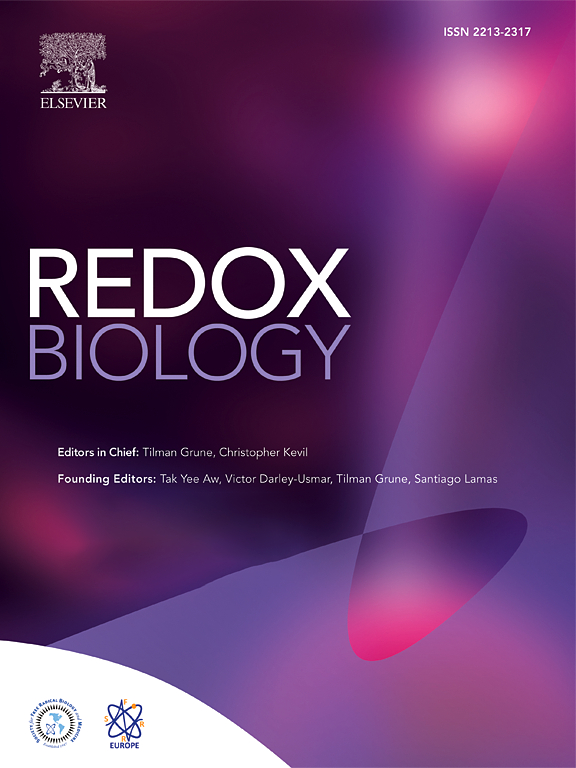Bioenergetic shift and proteomic signature induced by lentiviral-transduction of GFP-based biosensors
IF 10.7
1区 生物学
Q1 BIOCHEMISTRY & MOLECULAR BIOLOGY
引用次数: 0
Abstract
Fluorescent proteins (FPs) stand as pivotal tools extensively employed across diverse biological research endeavors in various model systems. However, long-standing concerns surround their use due to the numerous side effects associated with their expression. Recent investigations have brought to light the significance of hydrogen peroxide (H2O2) that is associated with the maturation process of green fluorescent protein (GFP) fluorophores. The structural and functional impairments associated with GFP expression are possibly linked to this amount of H2O2. In this study, we assess the impact of the GFP-based HyPer7 biosensor on cellular homeostasis and proteome changes, aiming to identify potential risks related to oxidative stress responses that potentially risks the application of such tools. Cells expressing genome-integrated HyPer7 demonstrated altered mitochondrial membrane potential (MMP), which was alleviated by the addition of antioxidants or culturing cells at physiological normoxia (5 kPa O2). Additionally, HyPer7-expressing cells also exhibited significant impairment in mitochondrial oxidative respiration, suggesting broader mitochondrial dysfunction. Through untargeted proteomics analysis, we identified 26 proteins exhibiting differential expression in HyPer7-expressing cells compared to respective control cells. Functional annotation analysis showed that the list of the delineated proteins is associated with cellular responses to stress and the regulation of antioxidant mechanisms. Our findings underscore the significance of caution and validation in ensuring a thorough comprehension of cellular responses when using fluorescent protein-based tools, thereby enhancing the reliability of the results.
慢病毒转导 GFP 生物传感器诱导的生物能转变和蛋白质组特征
荧光蛋白(FPs)是在各种模型系统中广泛应用于各种生物研究的关键工具。然而,由于荧光蛋白的表达会产生许多副作用,人们长期以来一直担心荧光蛋白的使用问题。最近的研究发现,过氧化氢(H2O2)与绿色荧光蛋白(GFP)荧光团的成熟过程有关。与 GFP 表达相关的结构和功能损伤可能与 H2O2 的含量有关。在本研究中,我们评估了基于 GFP 的 HyPer7 生物传感器对细胞稳态和蛋白质组变化的影响,旨在确定与氧化应激反应有关的潜在风险,这些风险可能会危及此类工具的应用。表达基因组整合 HyPer7 的细胞显示出线粒体膜电位(MMP)的改变,添加抗氧化剂或在生理常氧(5 kPa O2)条件下培养细胞可缓解这种改变。此外,HyPer7 表达细胞的线粒体氧化呼吸也表现出明显的障碍,这表明线粒体功能障碍的范围更广。通过非靶向蛋白质组学分析,我们发现了26种蛋白质在HyPer7表达细胞中的表达与对照细胞相比有所不同。功能注释分析表明,这些蛋白质与细胞对应激的反应和抗氧化机制的调节有关。我们的研究结果表明,在使用基于荧光蛋白的工具时,必须小心谨慎并进行验证,以确保全面了解细胞的反应,从而提高结果的可靠性。
本文章由计算机程序翻译,如有差异,请以英文原文为准。
求助全文
约1分钟内获得全文
求助全文
来源期刊

Redox Biology
BIOCHEMISTRY & MOLECULAR BIOLOGY-
CiteScore
19.90
自引率
3.50%
发文量
318
审稿时长
25 days
期刊介绍:
Redox Biology is the official journal of the Society for Redox Biology and Medicine and the Society for Free Radical Research-Europe. It is also affiliated with the International Society for Free Radical Research (SFRRI). This journal serves as a platform for publishing pioneering research, innovative methods, and comprehensive review articles in the field of redox biology, encompassing both health and disease.
Redox Biology welcomes various forms of contributions, including research articles (short or full communications), methods, mini-reviews, and commentaries. Through its diverse range of published content, Redox Biology aims to foster advancements and insights in the understanding of redox biology and its implications.
 求助内容:
求助内容: 应助结果提醒方式:
应助结果提醒方式:


